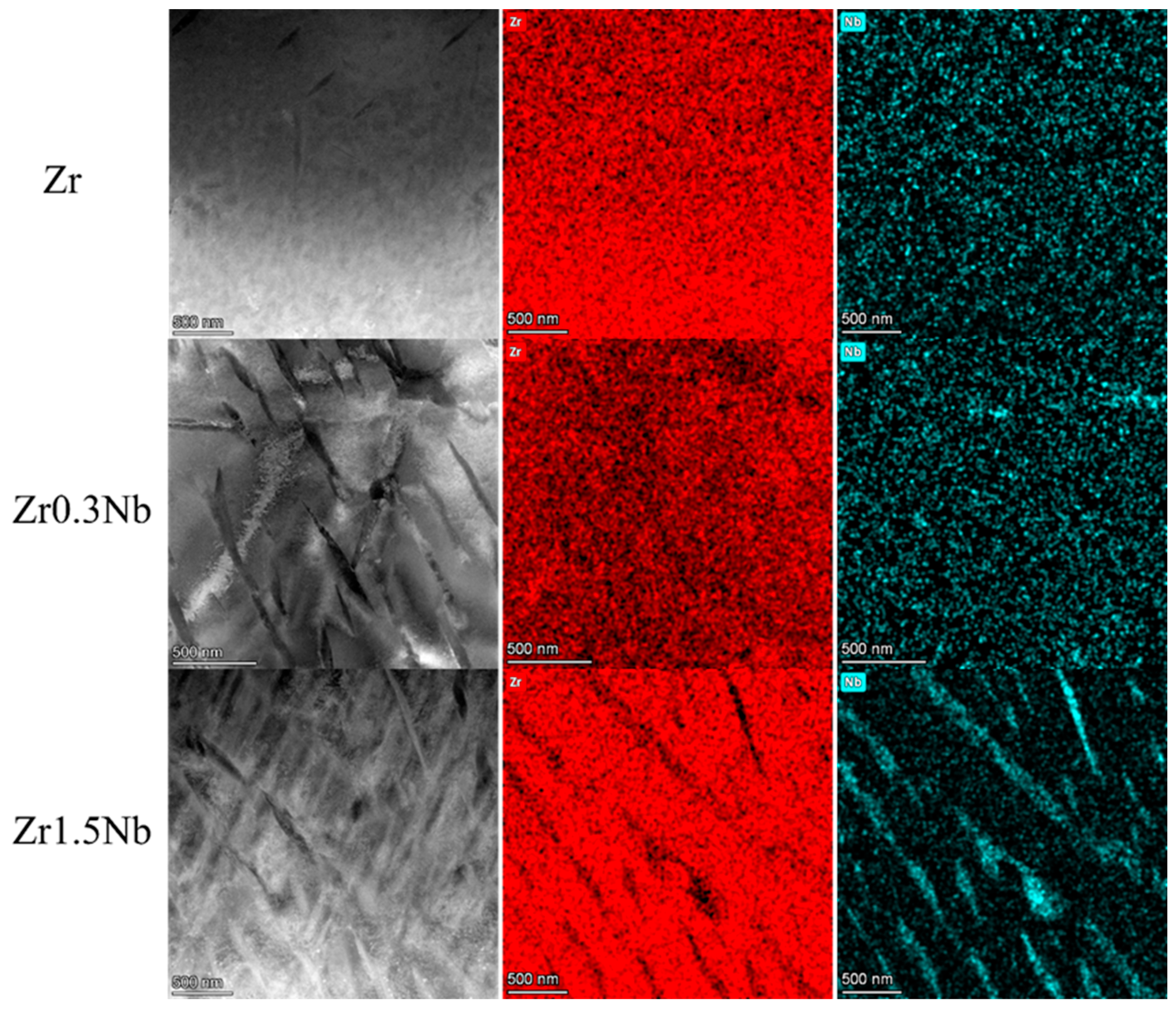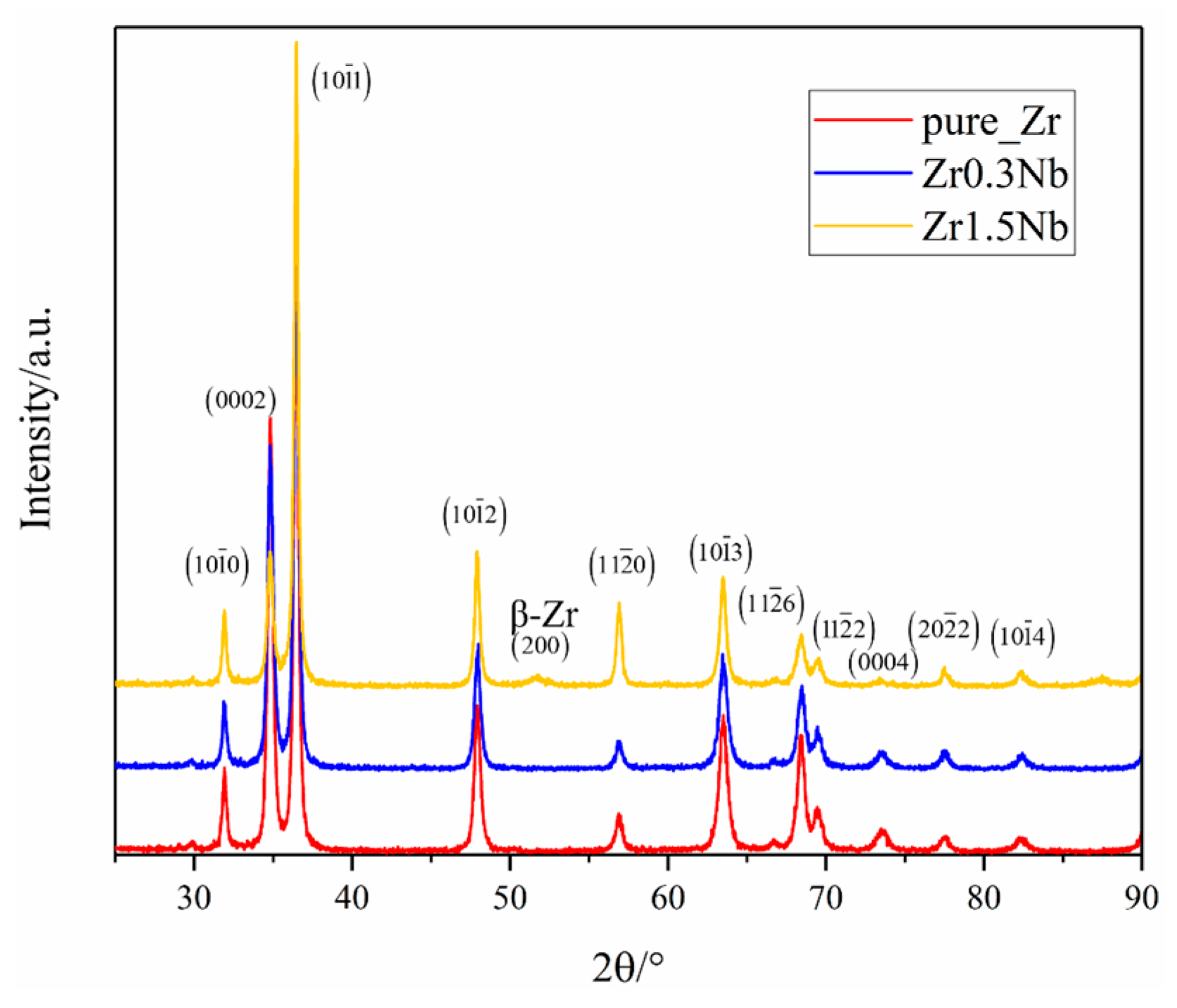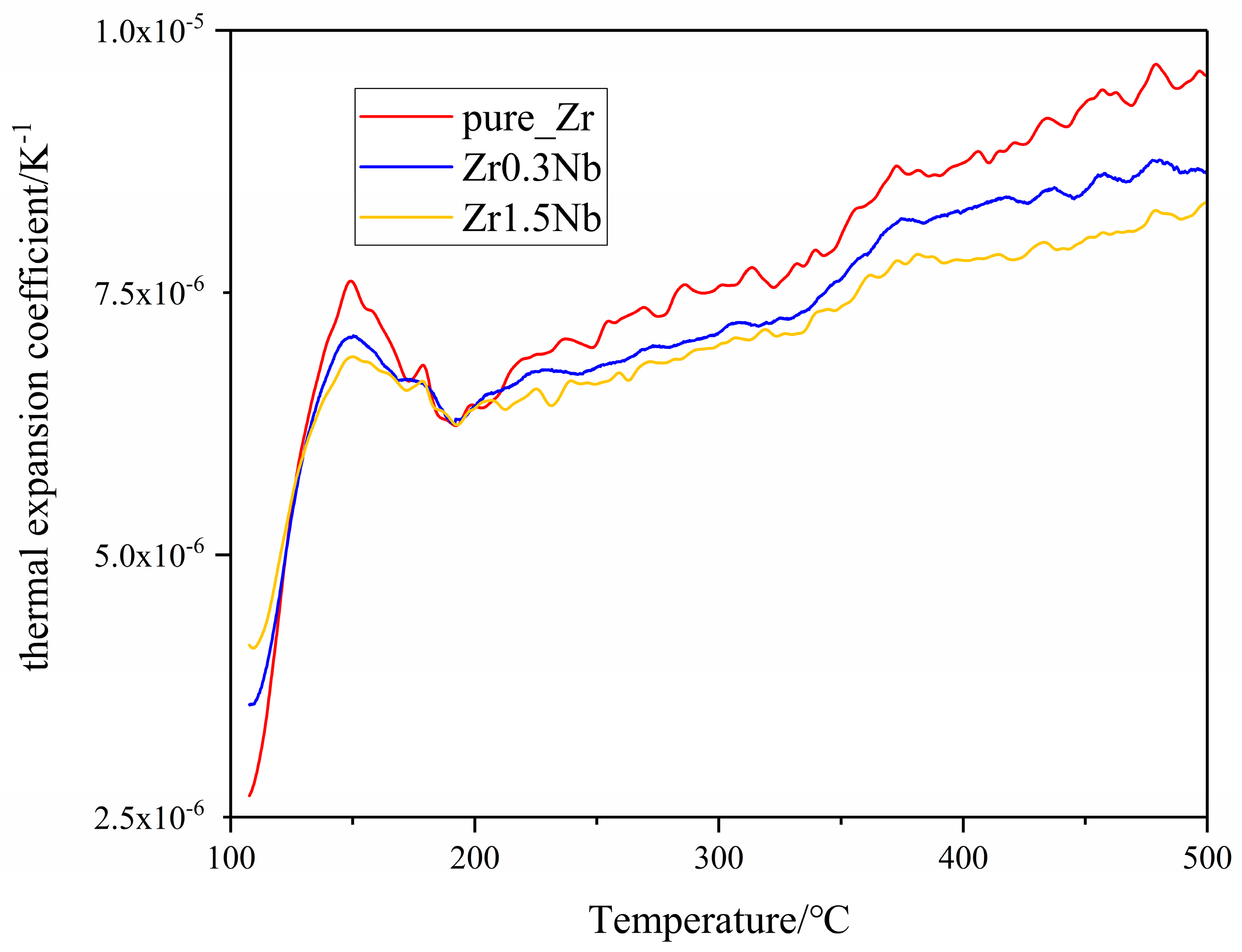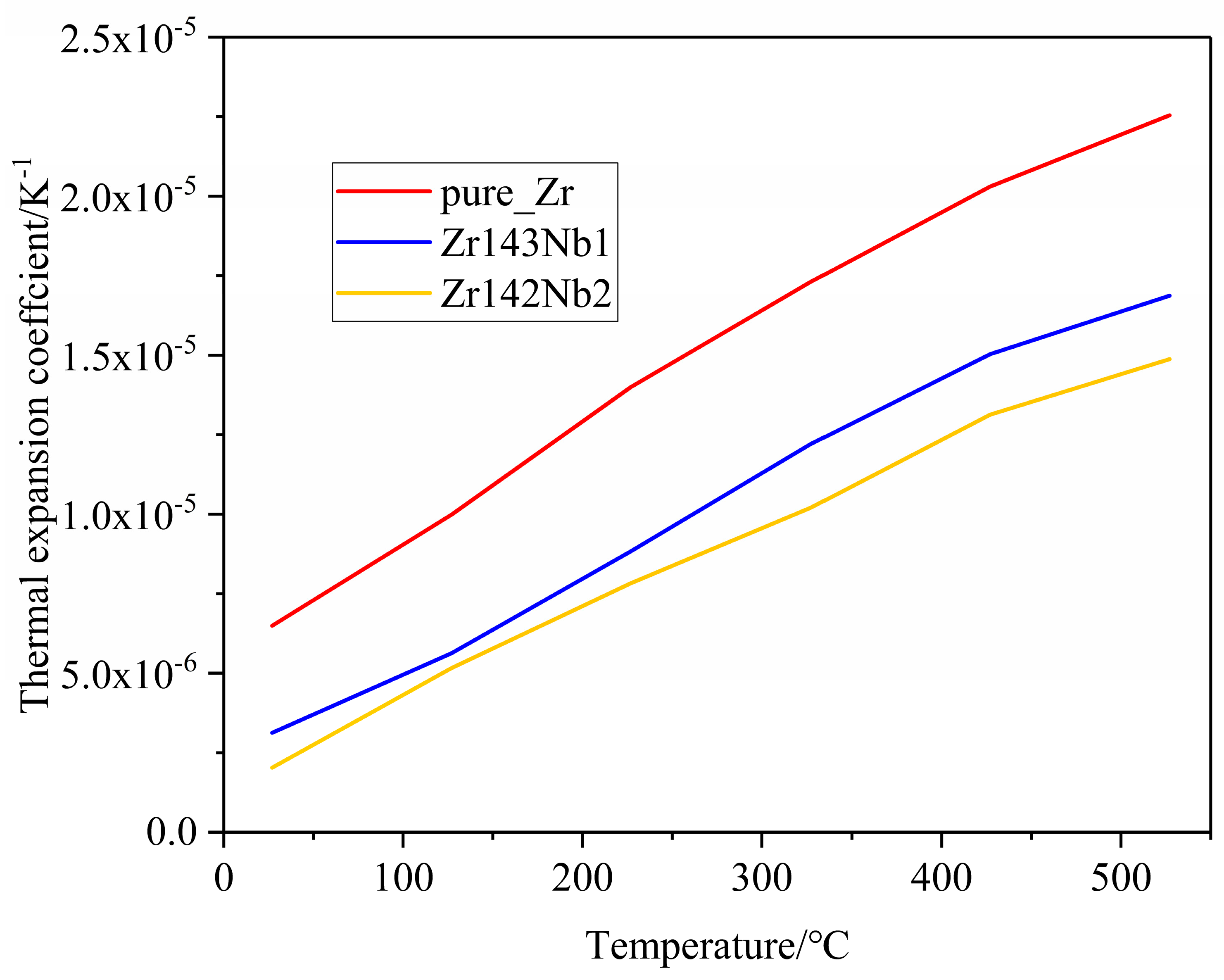The Effect of Niobium on the Mechanical and Thermodynamic Properties of Zirconium Alloys
Abstract
1. Introduction
2. Experimental and Theoretical Calculation Methods
2.1. Experimental Methods
2.2. Theoretical Calculation Methods
3. Experimental Results and Discussion
3.1. XRD Phase Structure Analysis
3.2. Electron Backscatter Diffraction (EBSD) Characterization
3.3. The Mechanical Properties
3.4. Thermal Expansion Coefficients
3.5. Thermal Conductivity of Pure Zirconium and Zirconium Alloy
4. Conclusions
Author Contributions
Funding
Data Availability Statement
Conflicts of Interest
References
- Kautz, E.; Gwalani, B.; Yu, Z.; Varga, T.; Geelhood, K.; Devaraj, A.; Senor, D. Investigating zirconium alloy corrosion with advanced experimental techniques: A review. J. Nucl. Mater. 2023, 585, 154586. [Google Scholar] [CrossRef]
- Adamson, R.B.; Coleman, C.E.; Griffiths, M. Irradiation creep and growth of zirconium alloys: A critical review. J. Nucl. Mater. 2019, 521, 167–244. [Google Scholar] [CrossRef]
- Griffiths, M. Microstructural Effects on Irradiation Creep of Reactor Core Materials. Materials 2023, 16, 2287. [Google Scholar] [CrossRef] [PubMed]
- King, D.J.M.; Knowles, A.J.; Bowden, D.; Wenman, M.R.; Capp, S.; Gorley, M.; Shimwell, J.; Packer, L.; Gilbert, M.R.; Harte, A. High temperature zirconium alloys for fusion energy. J. Nucl. Mater. 2022, 559, 153431. [Google Scholar] [CrossRef]
- Northwood, D.O. The development and applications of zirconium alloys. Mater. Des. 1985, 6, 58–70. [Google Scholar] [CrossRef]
- Francis, E.; Babu, R.P.; Harte, A.; Martin, T.L.; Frankel, P.; Jädernäs, D.; Romero, J.; Hallstadius, L.; Bagot, P.A.J.; Moody, M.P.; et al. Effect of Nb and Fe on damage evolution in a Zr-alloy during proton and neutron irradiation. Acta Mater. 2019, 165, 603–614. [Google Scholar] [CrossRef]
- Devi, A.; Srivastava, A.P.; Menon, R.; Mani Krishna, K.V.; Neogy, S.; Kumar, G.; Nabhiraj, P.Y.; Srivastava, D.; Dey, G.K. Study on the effect of Ar9+ ion irradiation of Zr–2.5 wt.% Nb alloy pressure tube. Philos. Mag. 2019, 99, 438–467. [Google Scholar] [CrossRef]
- Gaumé, M.; Baldo, P.; Mompiou, F.; Onimus, F. In-situ observation of an irradiation creep deformation mechanism in zirconium alloys. Scr. Mater. 2018, 154, 87–91. [Google Scholar] [CrossRef]
- Zhu, H.; Qin, M.; Wei, T.; Davis, J.; Ionescu, M. Atomic-scale study of He ion irradiation-induced clustering in α-Zirconium. Acta Mater. 2023, 244, 118584. [Google Scholar] [CrossRef]
- Tunes, M.A.; Harrison, R.W.; Greaves, G.; Hinks, J.A.; Donnelly, S.E. Effect of He implantation on the microstructure of zircaloy-4 studied using in situ TEM. J. Nucl. Mater. 2017, 493, 230–238. [Google Scholar] [CrossRef]
- Yan, C.; Wang, R.; Wang, Y.; Wang, X.; Bai, G.; Zhang, Y.; Lu, E.; Wang, B. Effect of Xe26+ ion irradiation on the microstructural evolution and mechanical properties of Zr–1Nb at room and high temperature. J. Nucl. Mater. 2015, 461, 78–84. [Google Scholar] [CrossRef]
- Dong, Q.; Qin, H.; Yao, Z.; Daymond, M.R. Irradiation damage and hardening in pure Zr and Zr-Nb alloys at 573 K from self-ion irradiation. Mater. Des. 2019, 161, 147–159. [Google Scholar] [CrossRef]
- Dong, Q.; Qin, H.; Yao, Z.; Wang, Q.; Daymond, M.R. Effect of the addition of Cu on irradiation induced defects and hardening in Zr-Nb alloys. J. Nucl. Mater. 2019, 519, 10–21. [Google Scholar] [CrossRef]
- Khan, M.I.; St Lawrence, S.; Klassen, R.J. Effect of Zr+ irradiation damage and crystal orientation on the uniaxial deformation of Zr–2.5%Nb micro-pillars: Part 1, deformation of single-phase αZr micro-pillars. Can. Metall. Q. 2021, 60, 28–40. [Google Scholar] [CrossRef]
- Griffiths, M.; Loretto, M.H.; Smallman, R.E. Electron damage in zirconium: I. defect structure and loop character. J. Nucl. Mater. 1983, 115, 313–322. [Google Scholar] [CrossRef]
- Drouet, J.; Dupuy, L.; Onimus, F.; Mompiou, F. A direct comparison between in-situ transmission electron microscopy observations and Dislocation Dynamics simulations of interaction between dislocation and irradiation induced loop in a zirconium alloy. Scr. Mater. 2016, 119, 71–75. [Google Scholar] [CrossRef]
- Doriot, S.; Onimus, F.; Gilbon, D.; Mardon, J.P.; Bourlier, F. Transmission electron microscopy study of second phase particles irradiated by 2 MeV protons at 350 °C in Zr alloys. J. Nucl. Mater. 2017, 494, 398–410. [Google Scholar] [CrossRef]
- Wei, J.; Frankel, P.; Polatidis, E.; Blat, M.; Ambard, A.; Comstock, R.J.; Hallstadius, L.; Hudson, D.; Smith, G.D.W.; Grovenor, C.R.M.; et al. The effect of Sn on autoclave corrosion performance and corrosion mechanisms in Zr–Sn–Nb alloys. Acta Mater. 2013, 61, 4200–4214. [Google Scholar] [CrossRef]
- Zee, R.H.; Rogerson, A.; Carpenter, G.J.C.; Watters, J. Effect of tin on the irradiation growth of polycrystalline zirconium. J. Nucl. Mater. 1984, 120, 223–229. [Google Scholar] [CrossRef]
- Shebaldov, P.V.; Peregud, M.M.; Nikulina, A.V. E110 Alloy Cladding Tube Properties and Their Interrelation with Alloy Structure-Phase Condition and Impurity Content. In International Symposium on Zirconium in the Nuclear Industry; ASTM International: West Conshohocken, PA, USA, 2000; pp. 545–559. [Google Scholar]
- Mardon, J.P.; Charquet, D.; Senevat, J.; Materials, A.S.F.T.A. Influence of Composition and Fabrication Process on Out-of-Pile and In-Pile Properties of M5 Alloy. In International Symposium on Zirconium in the Nuclear Industry; ASTM International: West Conshohocken, PA, USA, 2000; pp. 504–524. [Google Scholar]
- Warr, B.D.; Heide, P.A.W.V.D.; Maguire, M.A. Oxide characteristics and corrosion and hydrogen uptake in Zr-2.5 Nb CANDU pressure tubes. International Symposium on Zirconium in the Nuclear Industry; ASTM International: West Conshohocken, PA, USA, 1996; pp. 265–291. [Google Scholar]
- Sivabharathy, M.; Senthilkumar, A.; Sakthipandi, K.; Palanichamy, P.; Ramachandran, K. Thermal Expansion Studies on Zircaloy-2. Mater. Today Proc. 2016, 3 Pt B, 3064–3070. [Google Scholar] [CrossRef]
- Takahashi, Y.; Yamawaki, M.; Yamamoto, K. Thermophysical properties of uranium-zirconium alloys. J. Nucl. Mater. 1988, 154, 141–144. [Google Scholar] [CrossRef]
- Chen, W.; Bai, X.-M. Temperature and composition dependent thermal conductivity model for U-Zr alloys. J. Nucl. Mater. 2018, 507, 360–370. [Google Scholar] [CrossRef]
- Fink, J.K.; Leibowitz, L. Thermal conductivity of zirconium. J. Nucl. Mater. 1995, 226, 44–50. [Google Scholar] [CrossRef]
- Crocombette, J.-P.; Notargiacomo, P.; Marinica, M.C. Effect of the variation of the electronic density of states of zirconium and tungsten on their respective thermal conductivity evolution with temperature. J. Phys. Condens. Matter 2015, 27, 165501. [Google Scholar] [CrossRef]
- Wang, H.; Thomas, J.; Okuniewski, M.A.; Tomar, V. Microstructure dependent thermal conductivity measurement of Zircaloy-4 using an extended Raman thermometry method. J. Nucl. Mater. 2020, 539, 152338. [Google Scholar] [CrossRef]
- Isaenkova, M.G.; Tenishev, A.V.; Krymskaya, O.A.; Stolbov, S.D.; Mikhal’chik, V.V.; Fesenko, V.A.; Klyukova, K.E. Influence of the structural state and crystallographic texture of Zr-2.5% Nb alloy samples on the anisotropy of their thermal expansion. Nucl. Mater. Energy 2021, 29, 101071. [Google Scholar] [CrossRef]
- Isaenkova, M.G.; Tenishev, A.V.; Perlovich, Y.A.; Stolbov, S.D.; Mikhalchik, V.V.; Fedotov, P.V.; Novikov, V.V.; Kuznetsov, V.I. Regularities of Thermal Expansion of Cladding Tubes and Rods Made of E110opt Alloy within the Temperature Range of 273–1473 K (20–1200 °C). Inorg. Mater. Appl. Res. 2021, 12, 820–830. [Google Scholar] [CrossRef]
- Choo, K.N.; Kang, Y.H.; Pyun, S.I.; Urbanic, V.F. Effect of composition and heat treatment on the microstructure and corrosion behavior of Zr Nb alloys. J. Nucl. Mater. 1994, 209, 226–235. [Google Scholar] [CrossRef]
- Yang, H.L.; Matsukawa, Y.; Kano, S.; Duan, Z.G.; Murakami, K.; Abe, H. Investigation on microstructural evolution and hardening mechanism in dilute Zr–Nb binary alloys. J. Nucl. Mater. 2016, 481, 117–124. [Google Scholar] [CrossRef]
- Guillermet, A.F. Thermodynamic analysis of the stable phases in the Zr-Nb system and calculation of the phase diagram. Ztschrift Fur Met. 1991, 82, 478–487. [Google Scholar]
- Abriata, J.P.; Bolcich, J.C. The Nb−Zr (Niobium−Zirconium) system. J. Phase Equilibria 1982, 3, 34–44. [Google Scholar] [CrossRef]
- Cottura, M.; Clouet, E. Solubility in Zr-Nb alloys from first-principles. Acta Mater. 2018, 144, 21–30. [Google Scholar] [CrossRef]
- Kresse, G.; Hafner, J. Ab initio molecular dynamics for liquid metals. Phys. Rev. B 1993, 47, 558–561. [Google Scholar] [CrossRef] [PubMed]
- Kresse, G.; Furthmüller, J. Efficiency of ab-initio total energy calculations for metals and semiconductors using a plane-wave basis set. Comput. Mater. Sci. 1996, 6, 15–50. [Google Scholar] [CrossRef]
- Blöchl, P.E. Projector augmented-wave method. Phys. Rev. B 1994, 50, 17953–17979. [Google Scholar] [CrossRef] [PubMed]
- Perdew, J.P.; Burke, K.; Ernzerhof, M. Generalized Gradient Approximation Made Simple. Phys. Rev. Lett. 1996, 77, 3865–3868. [Google Scholar] [CrossRef] [PubMed]
- Wang, S.Q.; Ye, H.Q. Ab initio elastic constants for the lonsdaleite phases of C, Si and Ge. J. Phys. Condens. Matter. 2003, 15, 5307–5314. [Google Scholar] [CrossRef]
- Chen, X.Q.; Niu, H.Y.; Li, D.Z.; Li, Y.Y. Modeling hardness of polycrystalline mate-rials and bulk metallic glasses. Intermetallics 2011, 19, 1275–1281. [Google Scholar] [CrossRef]
- Plimpton, S. Fast Parallel Algorithms for Short-Range Molecular Dynamics. J. Comput. Phys. 1995, 117, 1–19. [Google Scholar] [CrossRef]
- Xin, X.K.; Lai, W.S.; Liu, B.X. Point defect properties in hcp and bcc Zr with trace solute Nb revealed by ab initio calculations. J. Nucl. Mater. 2009, 393, 197–202. [Google Scholar] [CrossRef]
- Chen, X.Y.; Wang, D.; Yao, B.D.; Wu, L.; Wu, X.Y.; Wang, Y.X. Mechanical and thermal properties of zirconium claddings after doping niobium: Understanding from first-principles calculations. J. Nucl. Mater. 2022, 568, 153876. [Google Scholar] [CrossRef]
- Kutty, T.R.G.; Ravi, K.; Ganguly, C. Studies on hot hardness of Zr and its alloys for nuclear reactors. J. Nucl. Mater. 1999, 265, 91–99. [Google Scholar] [CrossRef]
- Lu, H.-J.; Wu, H.; Zou, N.; Lu, X.-G.; He, Y.-L.; Morgan, D. First-principles investigation on diffusion mechanism of alloying elements in dilute Zr alloys. Acta Mater. 2018, 154, 161–171. [Google Scholar] [CrossRef]
- Kong, X.G.; Wang, Q.Q.; Yu, Y.; Shen, Y.H.; Zhang, C.Y.; Pan, R.J.; Kharchenko, D.O.; Mao, J.J.; Ning, Z.N.; Fang, Z.Q.; et al. Effect of solute Nb and Sn on self-interstitial atom defect in zirconium-based alloys by first-principles calculations. J. Nucl. Mater. 2024, 588, 154795. [Google Scholar] [CrossRef]









| Sample | Nb (wt%) | Fe (wt%) | Zr (wt%) |
|---|---|---|---|
| Zr | - | 0.05% | ≥99.9% |
| Zr0.3Nb | 0.39% | 0.10% | Bal. |
| Zr1.5Nb | 1.36% | 0.08% | Bal. |
| Strain | Energy Change |
|---|---|
| Zr144 | Zr143Nb1 | Zr142Nb2 | Experiment [45] | Zr54 [44] | Zr53Nb1 [44] | |
|---|---|---|---|---|---|---|
| C11 | 148.1 | 147.0 | 142.6 | 155.4 | 150.7 | 138.3 |
| C12 | 62.2 | 63.5 | 66.8 | 67.2 | 60.0 | 72.6 |
| C13 | 65.4 | 66.0 | 63.7 | 64.6 | 68.5 | 69.7 |
| C33 | 163.1 | 162.1 | 173.1 | 172.5 | 168.2 | 168.6 |
| C44 | 27.8 | 26.2 | 25.0 | 36.3 | 25.7 | 22.6 |
| BH | 93.8 | 94.0 | 93.8 | - | 95.7 | 96.3 |
| GH | 36.6 | 35.1 | 33.9 | - | 36.1 | 30.1 |
| Y | 97.1 | 93.8 | 90.8 | - | 96.2 | 81.9 |
| σ | 0.33 | 0.34 | 0.34 | - | 0.33 | 0.36 |
| Hv | 2.45 | 2.08 | 1.78 | 2.32 | 2.21 | 0.77 |
Disclaimer/Publisher’s Note: The statements, opinions and data contained in all publications are solely those of the individual author(s) and contributor(s) and not of MDPI and/or the editor(s). MDPI and/or the editor(s) disclaim responsibility for any injury to people or property resulting from any ideas, methods, instructions or products referred to in the content. |
© 2024 by the authors. Licensee MDPI, Basel, Switzerland. This article is an open access article distributed under the terms and conditions of the Creative Commons Attribution (CC BY) license (https://creativecommons.org/licenses/by/4.0/).
Share and Cite
Kong, X.; Kuang, H.; Li, A.; Yu, Y.; Kharchenko, D.O.; Mao, J.; Wu, L. The Effect of Niobium on the Mechanical and Thermodynamic Properties of Zirconium Alloys. Metals 2024, 14, 646. https://doi.org/10.3390/met14060646
Kong X, Kuang H, Li A, Yu Y, Kharchenko DO, Mao J, Wu L. The Effect of Niobium on the Mechanical and Thermodynamic Properties of Zirconium Alloys. Metals. 2024; 14(6):646. https://doi.org/10.3390/met14060646
Chicago/Turabian StyleKong, Xianggang, Huimin Kuang, An Li, You Yu, Dmitrii O. Kharchenko, Jianjun Mao, and Lu Wu. 2024. "The Effect of Niobium on the Mechanical and Thermodynamic Properties of Zirconium Alloys" Metals 14, no. 6: 646. https://doi.org/10.3390/met14060646
APA StyleKong, X., Kuang, H., Li, A., Yu, Y., Kharchenko, D. O., Mao, J., & Wu, L. (2024). The Effect of Niobium on the Mechanical and Thermodynamic Properties of Zirconium Alloys. Metals, 14(6), 646. https://doi.org/10.3390/met14060646






